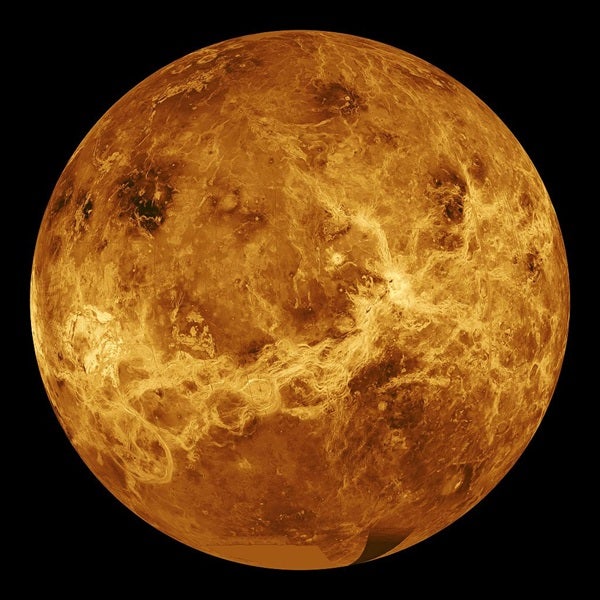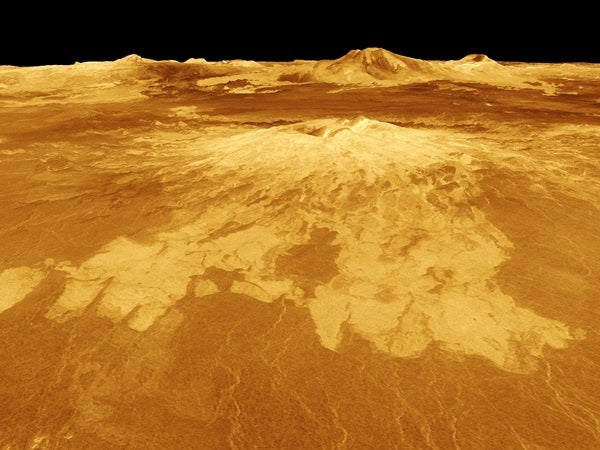Using numerical models to see how material in the planet’s mantle circulates, the results found that the planet couldn’t have undergone what is called mobile‐lid convection — a process where the surface rapidly sinks into the interior and is replaced by a fresh, crater-free surface. The results will help scientists understand how Venus evolved and may even help us understand how the planet’s runaway atmosphere came to be.
Earth and Venus formed during the same time and they have near-identical sizes, but any similarities end there. While Earth’s atmosphere is primarily nitrogen, Venus’ is almost entirely poisonous carbon dioxide. Most of the venusian surface is a landscape of smooth volcanic plains, some of which may still be active. Astronomers have long argued how Venus’ topography arose. Was it an abrupt mobile-lid convection event, or a continual surface renewal by active volcanoes?
Problem one: The offset
In a mobile-lid convection event, the lithosphere — the crust — sinks to settle along the core-mantle boundary. As the mass moves inward, it falls unevenly, leaving some areas thicker than others. So if a sudden event caused Venus’ entire lithosphere to sink below the surface, then there would be geologic evidence left behind. This evidence could be seen in an offset between Venus’ center of mass and the actual center of the planet — the CM-CF offset.
“It seemed to me that if material was recycled into the interior of the body, there would be significant mass anomaly, so I anticipated a CM-CF offset,” says Scott King, the paper’s author and a researcher at Virginia Tech.
Observations have shown there is a slight offset. However, the models created to reconstruct such an event each found a much higher offset than the one observed on Venus.
Offsets like Venus’ aren’t unusual; all the terrestrial bodies have them. On Earth it may be caused by the greater landmass in the Northern hemisphere. “On Mars, the Tharsis swell — not just the major shield volcanoes but the 5,000-kilometer-diameter region that is volcanic construct — is likely the cause of the CM-CF offset,” says King. “I don’t think there is one unique explanation for CM-CF offsets.”
In addition to the offset, other clues led King to reject the mobile-lid convection theory. Inside Earth, conductive molten material, like iron, continually circulates, causing what scientists call a dynamo — the mechanism that creates the planet’s magnetic field. “Given the similarity between the sizes and compositions of Venus and Earth, I would expect a venusian dynamo would be similar to an Earth dynamo,” said King.
Venus, however, barely has a magnetic field. The numerical models suggest that if a mobile-lid convection event did occur, the leftover heat coming from the core should be sufficient for a dynamo. As a result, the magnetic field should be much stronger than it actually is — further evidence against a dramatic resurfacing event.
Many more mysteries
The results may also hold clues about the planet’s rotation. Venus holds the solar system record for slowest rotation: 116 Earth days to one of its own. It also rotates backwards — a sunrise on Venus would be to the west. Both of these traits leave many astronomers to suggest that something massive must have collided with the planet. However, from the new results the author speculates such an event is inconsistent with Venus’ center of mass offset and suggests a different mechanism may be needed to explain the planet’s peculiarities.
While the new research narrows down the possibilities behind Venus’ fresh face, it doesn’t definitively point to one answer. “While I think my work more or less disproves the mobile-lid convection, I don’t think that is the same as proving the volcanic resurfacing event,” says King. “There could be some other mechanism, possibly even as of yet not discovered. So I want to leave the door open.”
Further research is needed to prove, or disprove, the volcanic theory and additional studies are needed to reconcile Venus’ paltry magnetic field and its peculiar rotation. Until then, Venus remains a maverick planet in the terrestrial family.

Would you like to learn more about the mysterious planet Venus? Check out our free downloadable eBook: Venus and Mercury: Hot, volatile planets.











